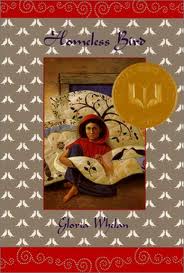Homeless Bird by Gloria Whelan
Reviewed by Karen

Ratings Explanation
Violence: Two men grab Koly. She wrestles away, and is slapped on the first.
Sexual Content: A man in the holy city of Vrindavan is looking for young girls from the country. He spots Koly and grabs hold of her. He clearly has immoral intentions. Koly has been warned and frees herself. Later, Koly is at a co-worker’s party when a lecherous artist stares at her and says he wants to paint a picture of her. He has bad intentions for her as well. American television programs are referred to as being “very improper.”
Adult Content: Koly’s mother-in-law treats her poorly. She verbally abuses and berates her. She is given the hardest of all the household tasks. When Koly travels to the Ganges, she sees holy men “who wore nothing at all.” When Koly is left alone in Vrindavan, she has to sleep on the street. She suffers great anxiety and fear over being homeless. A co-worker, Mala, steals from their employer and Koly finds out. At this co-worker’s party, Koly’s drink is intentionally laced with bhang (marijuana) by the artist. She drinks it unknowingly.
Synopsis
Koly is a thirteen-year-old Indian girl who mistakenly enters into an unfortunate arranged marriage. Soon after the marriage, Koly finds herself a widow living with her in-laws. (Social mores prevented Koly from returning home to her parents.) Her mother-in-law (her “sass”) is verbally and emotionally abusive to Koly, forcing her to do the hardest household tasks. Koly’s father-in-law (her “sassur”) is too timid to stand up to his wife in how she treats Koly, but he does secretly teach her to read and write. This begins to give Koly comfort and confidence. After her sassur dies, Koly finds herself abandoned and alone in a big city full of would-be friends and foes. Koly faces her new life with courage, and through her special embroidery talents, she saves herself–all within the realms of the established Indian customs.
This National Book Award winner was based on a newspaper article read by the author. It was interesting to find out more about the centuries-old culture of India. At first, I assumed this book took place a hundred or more years ago, but I soon realized that this type of underage/arranged marriage, the plight and shame of being a young widow, and the caste systems described, are alive and well in India toady. Koly is a strong heroine of the highest character who takes control of her own destiny, after being used as a pawn as a young teen. I enjoyed reading this very well researched book. There is a dictionary, of sorts, at the end of the book with definitions of the Indian vocabulary used within.








